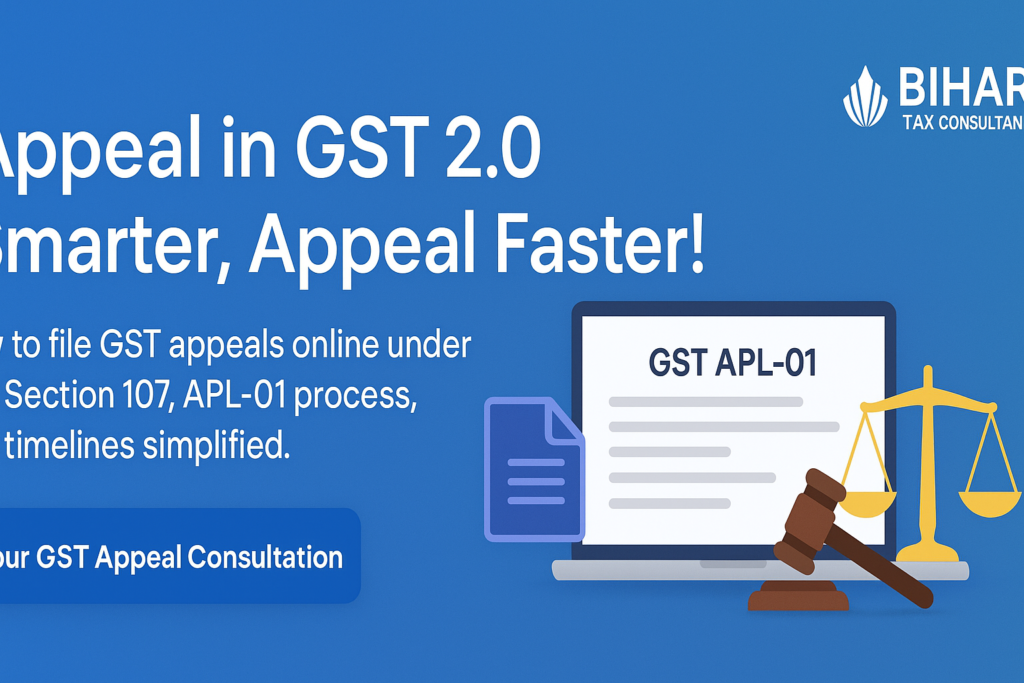
Introduction – Understanding GST Appeal in GST 2.0
The Goods and Services Tax (GST) system continues to evolve in India, and GST 2.0 marks a major technological and procedural upgrade. One of its most crucial components is the GST Appeal mechanism, which enables taxpayers to challenge any decision or order issued by tax authorities.
An appeal under GST 2.0 is a legal remedy that provides taxpayers an opportunity to seek redressal before higher authorities. This ensures transparency, accountability, and fairness in the tax adjudication process.
Legal Framework: Section 107 of the CGST Act
The right to appeal under GST is governed by Sections 107 to 121 of the Central Goods and Services Tax Act, 2017 and Rules 108 to 116 of the CGST Rules, 2017.
Section 107 deals with appeals to the Appellate Authority.
It allows any person aggrieved by a decision or order passed by an adjudicating authority to file an appeal within three months from the date of communication of the order.
The appeal must be filed in Form GST APL-01 along with supporting documents and proof of pre-deposit.
🔗 Read the full CGST Act here.
Key Changes Introduced in GST 2.0 for Appeals
GST 2.0 simplifies the appeal filing process with enhanced automation and transparency:
Integrated Online Filing: Appeals can now be filed entirely online through the GST 2.0 portal without manual submissions.
Automated Validation: The system validates jurisdiction, order details, and payment before submission.
E-Communication: All notices, hearing dates, and orders are communicated digitally.
Tracking & Acknowledgement: Applicants receive an acknowledgment and can track appeal status in real time.
Integration with APL Forms: Forms GST APL-01 (appeal submission) and APL-02 (acknowledgement) are system-linked for procedural accuracy.
Types of Appeals under GST Law
First Appeal – Filed before the Appellate Authority under Section 107.
Second Appeal – Filed before the Appellate Tribunal under Section 112.
High Court / Supreme Court Appeals – For substantial questions of law or constitutional interpretation.
Each level ensures checks and balances within the GST framework.
Step-by-Step Procedure to File GST Appeal
Filing a GST Appeal in GST 2.0 involves a structured process:
1️⃣ Filing Form GST APL-01
Log in to the GST Portal.
Navigate to Services → User Services → My Applications → Appeal to Appellate Authority.
Select the relevant order number and upload required documents.
Pay the prescribed pre-deposit (10% of disputed tax).
Submit Form GST APL-01 digitally signed.
2️⃣ Required Documents and Fees
Copy of the order or decision appealed against
Grounds of appeal and statement of facts
Proof of payment of admitted tax and pre-deposit
Supporting evidence (invoices, ledgers, etc.)
🧾 Fees: As per Rule 108(2) of CGST Rules, the prescribed fee is payable electronically along with the appeal.
Timelines and Limitation for Filing Appeal
Standard Time Limit: 3 months from the date of communication of the order.
Condonation: The Appellate Authority may allow an additional 1-month extension if valid reasons are provided.
Departmental Appeals: Must be filed within 6 months from the date of order.
📘 Reference: CBIC Circular No. 132/2/2020-GST.
Authority and Jurisdiction for Appeals
| Type of Authority | Jurisdiction | Relevant Section |
|---|---|---|
| Appellate Authority | State or Central jurisdiction depending on adjudicating officer | Section 107 |
| Appellate Tribunal | National/State Bench | Section 112 |
| High Court | State jurisdiction | Section 117 |
| Supreme Court | National jurisdiction | Section 118 |
Common Grounds for Rejection or Dismissal
Late filing beyond permissible limit without sufficient cause
Incomplete documentation or missing pre-deposit proof
Appeal filed before the wrong authority or jurisdiction
Failure to attend hearings or respond to notices
💡 Tip: Always verify the appeal type and authority before submission to avoid dismissal.
Case Study: Successful Appeal under GST 2.0
A small manufacturer in Patna, Bihar received an adverse order for ITC mismatch. The taxpayer filed an appeal via GST 2.0 using Form APL-01, attached reconciliation statements, and paid the 10% pre-deposit.
After detailed hearing, the Appellate Authority accepted the reconciliation evidence and reversed the penalty, citing compliance with Section 107(6).
Learning: Proper documentation and timely filing can substantially improve the chances of a favorable outcome.
Conclusion – Best Practices and Compliance Tips
File appeals promptly within the limitation period.
Maintain complete records of tax returns and reconciliations.
Verify jurisdiction before filing to avoid procedural rejection.
Always attach proof of pre-deposit and payment of admitted tax.
Engage a qualified GST professional or legal expert for drafting and representation.
📞 Need help filing your GST Appeal?
Contact Bihar Tax Consultant for expert representation and error-free filing under GST 2.0.
Frequently Asked Questions (FAQ)
Q1. What is a GST Appeal in GST 2.0?
It’s a formal process to challenge tax orders through the upgraded GST 2.0 system.
Q2. Who can file an appeal under GST?
Any taxpayer or department aggrieved by a GST order or decision.
Q3. What is the time limit for filing a GST appeal?
Appeals must be filed within 3 months from the date of the order.
Q4. Which form is used to file a GST appeal?
Form GST APL-01 is used for filing the first appeal electronically.
Q5. What are common reasons for GST appeals?
ITC mismatches, penalty disputes, or incorrect order assessments.
Q6. Is it mandatory to pay tax before appeal?
Yes, a 10% pre-deposit of the disputed tax amount is required.
Q7. Can an appeal be filed offline?
No, under GST 2.0, appeals are filed entirely online via the GST portal.
Q8. What happens after filing an appeal?
The Appellate Authority reviews and issues a decision within the prescribed period.
Q9. Can the appeal order be further challenged?
Yes, further appeal can be made to the Appellate Tribunal or High Court.
Q10. What are common mistakes to avoid in GST appeals?
Missing deadlines, incomplete documentation, or incorrect jurisdiction selection.
References
CBIC Circular No. 132/2/2020-GST
M/s XYZ Traders vs State Tax Officer (2023)
Author Bio

Cyber Crime Advocate in Patna
Advocate Tabish Ahmad (B.A. LL.B., LL.M., Diploma in Cyber Law – GLC Mumbai) is a Certified Cyber Law Practitioner and practising Advocate at the Patna High Court. He specializes in Cyber Crime, GST Litigation, and Tax Appeals, with extensive experience in representing clients before judicial and quasi-judicial forums.
He serves as President of the Cyber Lawyers Association and is a Member of the Advocates’ Association, Patna High Court. As a Mentor at the Indian Tax Academy and JurisCrack, he guides young lawyers and students in cyber and tax law practice.
Author of several books on Cyber Crimes, Taxation, and GST, Advocate Tabish Ahmad is recognized for his practical insights on digital law, data privacy, and cyber fraud defence.
📚 Category: GST 2.0
📅 Last Updated: November 6, 2025
Short Summary (for AI snippet)
Comprehensive guide on filing a GST Appeal in GST 2.0, covering legal provisions, procedures, forms, and timelines under Section 107 of the CGST Act for professionals in Bihar.
✅ Disclaimer: This article is for informational purposes only and does not constitute legal advice. Readers are advised to consult a qualified GST professional or legal expert before acting on any information provided herein.
